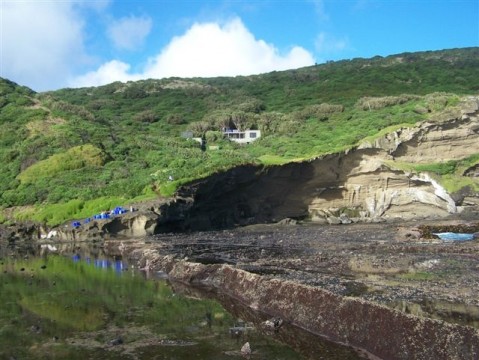The Chatham Islands: Exotically familiar
I recently returned from a trip to plant trees on one of our most windswept and distant archipelagos – the Chatham Islands.
The two week Department of Conservation trip begun with a car-ride around the main island which has been stripped of most of it trees, seeded with grassed and populated with cattle and sheep.
To a long-time conservationist like me, it was like an ecological desert.
The main thing to warm my heart were patches of remnant bush and wetland that are being well-tended by DOC and locals who keep all number of pests (read: wild sheep, cattle, cats, possums, hedgehogs, rats and mice) at bay.
The ten volcanic islands that make up the Chatham group rose from the sea 2-3 million years ago and quickly became a welcome landing spot for seeds and spores arriving from New Zealand.
The plants soon evolved to take advantage of the new conditions. For example, koromiko on New Zealand’s mainland are shrubs, on the Chathams they’re super-sized. Likewise, its mahoe has very thick leaves so it looks quite different from the NZ variety.
Gale force winds are common and one of my lasting memories of the trip is misshapen trees with branches that sit horizontally trailing off in the lee in the wind as if making a slow escape. There are no podocarps (like kauri, kahikatea and rimu) on the island so the flora doesn’t form lofty greenery, but rather a mid-level canopy.
After 2 days on the Chatham’s mainland, we crossed a stormy stretch of water to Mangere Island. From the rocky shore all seven of us gazed up at this small 113 hectare island that played a central role in our conservation history.
Once it was homeland to the Chatham Island black robin – a bird whose population dropped to just six individuals.
It was a dire situation with only one fertile female left. However with a mighty effort from Don Merton and the Wildlife Service, its population has bounced back.
Unlike the Chatham’s mainland, 90% of this offshore island is now covered in native plants. Ake ak (olearia) were planted in shelter belts 20 -30 years ago, and we helped to diversify this bush with touches of nikau, kawakawa, ngaio, matipo and lancewood.
Like New Zealand, the islands surrounding the mainland have become sanctuaries. Mangere was purchased by the NZ Government in 1966, declared a reserve soon after, and cleared of its pests.
Birds were then relocated back on the island. First came the Black Robin (1976), a small kiwi-like bird called a Snipe (1970), the Chatham Island Tomtit (1987) and Shore Plover (1990).
It is also home to an endemic parrot that can only be found on these two small islets – the Forbes’ parakeet.
While on the island two things really amazed me.
First, the insect life in the leaf litter was so prolific. At night, in an area 1m square, we’d see a dozen small weta plus scores of other creepy crawlies.
The soils are incredibly fertile due to the huge number of seabirds that come ashore bringing nutrients and digging burrows. We came across storm petrels nestled in the grass when we dug holes for the trees. Luckily we didn’t kill any.
Second, despite daytime temperatures around 8 degrees and frequent squalls of hail, there was a lot of plant growth – seedlings coming away and fresh shoots on some tree species. Here in Buller everything closes down for winter.
Our trip was very well organised, with a lot of attention paid to getting the plants firmly in the ground. Getting on and off the island in the stormy conditions is a potential nightmare but fortunately we got the weather breaks we needed.
We ate well – paua and kina on the island and wild pork, crayfish and fresh cod on Chatham.
The atmosphere at the DOC office was very friendly. I was welcomed and made to feel part of the family – it was just like the old New Zealand Forest Service where I worked in 1969-70.
I was paid $16 per hour for 80 hrs work and my transport from Westport was also paid. It is so different from DOC’s Southland conservancy where you have to pay to be a volunteer.
The Chathams would be a wonderful place to holiday. The only hurdle is the $1000 return air fare. A cheaper option is to go as a tree planter like me. Going to Mangere is the trip of a lifetime for a nature lover.

